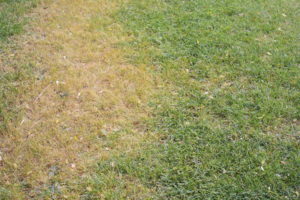
There are some tough diseases to watch for on your cool-season grasses in the fall, most of which are fungal.
A well-manicured lawn is the pride and joy of many homeowners, but maintaining the perfect lawn can be incredibly difficult when you have to constantly fight off pests, weeds, and diseases trying to take over. How you handle each will vary depending on the issue you’re dealing with and what kind of grass you have. There are many different varieties of each to watch out for, including several grass diseases that affect cool-season grasses.
Spring Dead Spot
Spring dead spot affects bermudagrass, as well as zoysia grasses. This can be a very difficult disease to get rid of, so preventive care is recommended. While spring dead spot isn’t technically a fall disease, this is when preventive care should happen. Use DMI fungicides or DMI + QoI combination products during the fall to prevent spring dead spot from attacking your lawn during the next growing season. This will go a long way for your lawn, especially if you have bermudagrass or zoysiagrass. Once this disease has been established, you can manage it best by breaking up the dead turf with aerification or spiking, applying fertilizer, and irrigating lightly and frequently.
Fairy Ring
Fairy ring is a dreaded cool-season grass disease because it can be very difficult to determine what kinds of fungicides will work. It’s also a problem because the fungi will alter the composition of your soil and cause type I and type II symptoms of varying degrees. Dead turf is considered a type I symptom, while darker and faster-growing turf is a type II symptom—both can be present around a single fairy ring.
More than 60 types of fungi have been documented to cause fairy ring, which means you will likely have to find the best fungicide through the process of elimination. The fact that this can’t be tackled easily or efficiently makes it one of the most annoying turf diseases to deal with.
Rust
Rust is a fungus that can infect turfgrass in every season other than winter, but it is most effective at infection during the cool and cloudy weather of fall, and it can be incredibly difficult to manage. Rust sends out spores in spring, summer, and fall to infect new tissue and spread. All infected plants will yellow and become more vulnerable to environmental stress. In fall, rust becomes even more obvious as it turns black in preparation for overwintering. You can use fungicides as a preventive measure or even choose to plant rust-resistant turf grasses to avoid this disease.
Have More Questions? Stay in Touch!
Order early and order often to ensure the best service possible. Contact us through our online page. Please find us at 27616 Little Lane, Salisbury, Maryland 21801. Our phone number is 410-726-6103, and our fax number is 410-742-6550. Speak to Jason Anderson for Turf Grass Sales. Reach him by email at jason@quanticocreeksod.com. Finally, follow us on social media on Facebook, LinkedIn, and our blog!
This entry was posted on Thursday, October 20th, 2022 at . Both comments and pings are currently closed.